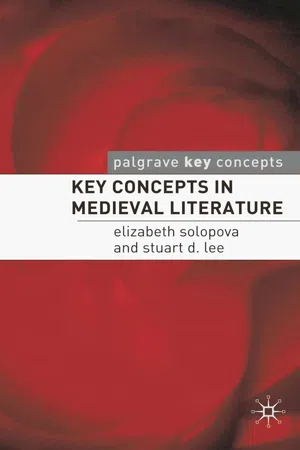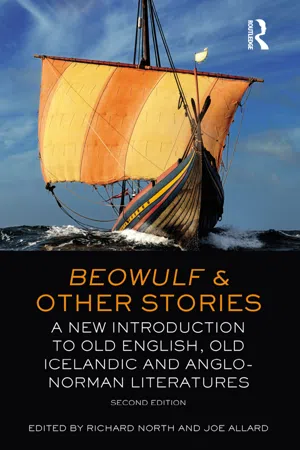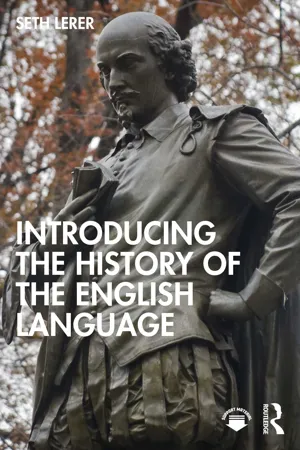Languages & Linguistics
Old English Translation
Old English translation refers to the process of rendering texts from Old English, the language spoken in England from the 5th to the 11th century, into modern languages. This involves understanding the nuances of Old English grammar, vocabulary, and syntax, and accurately conveying the meaning and style of the original text in the target language.
Written by Perlego with AI-assistance
Related key terms
Related key terms
1 of 4
Related key terms
1 of 3
3 Key excerpts on "Old English Translation"
- eBook - ePub
- Elizabeth Solopova, Stuart Lee(Authors)
- 2007(Publication Date)
- Bloomsbury Academic(Publisher)
4 Approaches, Theory, and Practice (a) Old English Language Students of medieval literature will have to encounter the texts in their original language at some point in their career. For the most part this will be in textbooks or editions, and the texts will be surrounded by critical apparatus to help the students read and translate the original. However, although there are many books which take one through the first steps of approaching the language it is worthwhile at this point presenting some basic information about the two periods of English covered in this book: Old English and Middle English. In the ‘family tree’ of languages Old English is said to be a Germanic language, and in particular a West Germanic language. In Figure 1 we can see this more clearly. This presents the Indo-European languages (so-called because it is assumed they all originate from a common language conventionally referred to as ‘Indo-European’). As we can see there are several main branches beneath the main heading; however, in this case we have only illustrated the Germanic family. This is split into three ‘geographical’ regions, and the important route to follow is the West Germanic branch. Following this we can see Old English and then Middle English. A diagram like this, then, shows not only the accepted development route of English, but also how it relates to other languages. However, this tree is very simplistic. It does not attempt to show the influences on languages from other languages and language groups. For example, in Old English we can discern words borrowed from Latin (a member of the Italic subgroup within the Indo-European family) before the migration period (e.g. 5th century), and later as a result of Christianisation and cultural contacts with other European countries (6th century onwards) - eBook - ePub
Beowulf and Other Stories
A New Introduction to Old English, Old Icelandic and Anglo-Norman Literatures
- Joe Allard, Richard North(Authors)
- 2014(Publication Date)
- Routledge(Publisher)
Naturally, I am going to take the position that Old English is not only easy but also worth learning. But along the way I shall try to give you enough information about the language to allow you to come to your own conclusion. Old English is a language like other languages OK, so Old English is a language. Why am I pointing out something as obvious as that? Old English used to be universally taught as a linguistics course, in which students learned not only the language, but also learned in great detail how each of its features had descended from Germanic and Indo-European originals. People who were forced to take such courses often moan (sometimes in the Guardian or Times Literary Supplement) about the pain and boredom of the experience. Historical linguistics – the study of how languages change over time – is a lively field that a great many students find fascinating. Many find it worthwhile to know the place of English in the Germanic sub-family of languages and the place of Germanic in the enormous and ancient Indo-European language family (see Chapter 1, p. 8). Many also find it edifying to learn how and why English has changed over the centuries, if only because the language is still changing, more or less rapidly, everywhere it is spoken. But you don’t need to become a historical linguist if your purpose is to read Beowulf or The Anglo-Saxon Chronicle, any more than you need to learn the history of French to read Flaubert or navigate the Champs Elysées. One would have thought it obvious to everyone that any language can be learned without resort to historical linguistics. But no, even today there are textbooks that insist, either explicitly or implicitly, that one must study certain ‘sound changes’ in order to learn Old English - eBook - ePub
- Seth Lerer(Author)
- 2024(Publication Date)
- Routledge(Publisher)
3 The Old English PeriodDOI: 10.4324/9781003227083-4Old English (OE) describes the Germanic vernacular spoken and written in the British Isles from roughly the middle of the fifth century until the early twelfth century. OE shared features of grammar, sounds, and vocabulary with other early Germanic languages and many modern ones. It was highly inflected, using word endings to determine the relationships among words in a sentence. Nouns had grammatical gender (masculine, feminine, and neuter); they belonged to certain groups or classes (depending on their sound histories of their roots); they were declined in a variety of cases, depending on their grammatical function; and there had to be agreement with adjectives that modified them (that is, similar endings depending on the number, case, and gender of the noun). Verbs were conjugated according to tense and number; verbs were also grouped into classes depending on their sounds and sound histories; and certain verbs formed their tenses by changing the root vowel (strong verbs, such as drink, drank, drunk) and others formed their tenses by adding a suffix (weak verbs, such as live, lived). OE had a distinctive sound (one that has been reconstructed, with reasonable accuracy, by scholars over the past three hundred years) and a distinctive way of forming letters in writing (adapting old runic letters for sounds not found in the Latin alphabet). It was the medium of prayer, scholarship, history, poetry, and philosophy for more than four hundred years.This chapter illustrates the distinctive features of OE and gives students basic reading knowledge of the language so that they may understand its place in English linguistic history and the literary imagination. We will also see how studying OE gives us access to a political and social world, to myth and religion, and to creativity and culture. OE was not a single, static language, however. Over the seven centuries of its use, it changed: new words came in from Latin and Scandinavian languages; word endings appear to have been leveled out or even lost; patterns of word order and particulars of literary style evolved. In addition, OE varied in sound and sense across the British Isles. Scholars have identified four major regional dialects by examining the spelling of words in surviving manuscripts. Old English was the language of kings and agricultural workers, poets and monks. It was a vernacular marked by nuance and variety, depending on the who, when, and where of its use.
Index pages curate the most relevant extracts from our library of academic textbooks. They’ve been created using an in-house natural language model (NLM), each adding context and meaning to key research topics.
Explore more topic indexes
Explore more topic indexes
1 of 6
Explore more topic indexes
1 of 4


